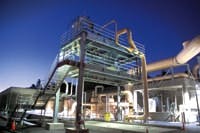Upgrading to energy-efficient lighting has become one of the simplest and most cost-effective solutions for water and wastewater treatment facilities to reduce operational costs and enhance safety and security. As more organizations also look to reduce their environmental impact, high-efficiency lighting also can significantly reduce the carbon footprint of facility operations to meet sustainability goals and mandates.
Recent advances in light-emitting diode (LED) lighting technology have made this efficient, low-maintenance option a good fit for both retrofit and new install applications. In fact, LEDs offer numerous advantages over conventional lighting technology like high-pressure sodium (HPS) and mercury vapor (MV) fixtures:
- • LEDs typically consume less than half the electricity of high-intensity discharge fixtures, which results in substantial power savings and reduction in carbon emissions.
- • LEDs are virtually maintenance free, providing up to 10 years or more of reliable performance. These solid-state electronic devices contain no bulbs or ballasts to change, and most products carry a five-year warranty. A long-life performance means that LEDs eliminate maintenance costs, which can save some facilities tens of thousands of dollars a year and free up maintenance workers to perform other vital operational duties, rather than spending time changing light bulbs.
- • LEDs improve visibility, delivering a clearer, crisper light that mimics natural daylight. Unlike HPS and MV sources that cast a dusky orange or blue glow, LEDs are a white light source that eliminates color distortion and makes it easier to distinguish colors of wiring, signage, equipment and other facility fixtures. Not only is the light from LEDs easier on the eyes for workers, it also offers a significant safety advantage—electricians, for example, must be able to distinguish wiring colors to avoid critical mistakes, and LEDs make this much easier and safer. Better visibility also can enhance facility security, as the white light improves images captured on closed-circuit video monitoring systems.
- • LEDs are more neighborhood friendly, with precision optics design that places the light exactly where it is needed, instead of broadcasting it into neighboring homes. In addition to eliminating light pollution, this also enhances lighting efficiency, so facilities get the most “bang for their buck” with light that is directed where it is needed, instead of being wasted by lighting up the sky and neighboring properties.
- • LEDs can qualify for energy efficiency rebates offered through utility providers, which can help offset the initial cost of an upgrade, making the retrofit even more affordable for any facility.
With the significant savings in energy and maintenance, an upgrade to LED lighting can actually pay for itself, providing a return on investment in, or payback period of, as little as one year in some cases.
Santa Cruz Savings
The City of Santa Cruz (Calif.) Wastewater Treatment Facility (WWTF) processes an average daily flow of 10 million gal per day (mgd), providing regional wastewater treatment and disposal for both the city and the Santa Cruz County Sanitation District, which includes the communities of Live Oak, Capitola, Soquel and Aptos. In operation since 1928, the facility has undergone numerous expansion projects to accommodate growth in the region and now boasts a rated design capacity of 17 mgd.
Aiming to achieve better visibility and reduce energy consumption, the facility recently modernized its exterior area and site lighting, upgrading from HPS and MV fixtures to new Dialight DuroSite LED fixtures in several areas.
Money & Time
With hundreds of fixtures to light its exterior structures 12 hours a day, seven days a week, the Santa Cruz treatment facility previously used a combination of HPS units ranging from 70 to 400 W and MV fixtures in 175 to 400 W models. For safety and security purposes, the entire facility is under 24/7 closed-circuit television surveillance—yet the poor quality of light emitted by the antiquated fixtures hindered visibility and reduced the image clarity of the closed-circuit system.
In addition, the HPS and MV fixtures required constant maintenance to change bulbs and ballasts, costing the plant both money and valuable personnel time. Not to mention, the cost of hazardous material disposal for the bulbs added to the ongoing maintenance expense and the environmental impact.
LED Solution
As part of a citywide Climate Action Program to reduce energy consumption and to resolve its lighting challenges, the facility experimented with several LED lighting solutions, including one from Dialight. Impressed with the way the Dialight fixture outperformed the others, the facility ultimately chose Dialight to replace 82 fixtures in its solids dewatering building, pre-aeration and trickling filters with the company ’s DuroSite LED fixtures, including 33 Low Bays specially designed for areas of low clearance, and 49 High Bays—19 with 14,000 lumen output and 30 with 12,000 lumen output.
The entire changeout took just five days—about 30 to 60 minutes per fixture. The 12/7 lighting was outfitted with a combination of photocells and timers, taking advantage of the Dialight LED’s instant-on capabilities.
Dramatic Improvements
LED fixtures typically draw less than half the wattage of HPS and MV (on average). With the new fixtures, the Santa Cruz facility reduced its lighting energy usage and cost by more than 50%, significantly lowered its CO2 emissions and realized a dramatic improvement in visibility, contributing to more robust security throughout the facility.
With each fixture expected to last up to 10 years, the retrofit has reduced lighting maintenance and costs for the next decade. A rebate also was approved through a local incentive program based on energy savings, and the entire project will pay for itself within three years.
Download: Here


